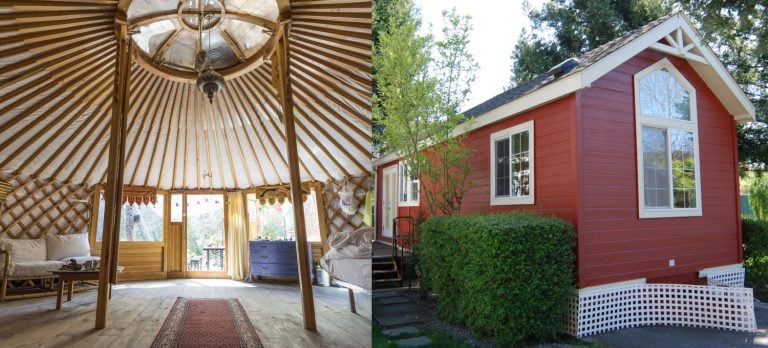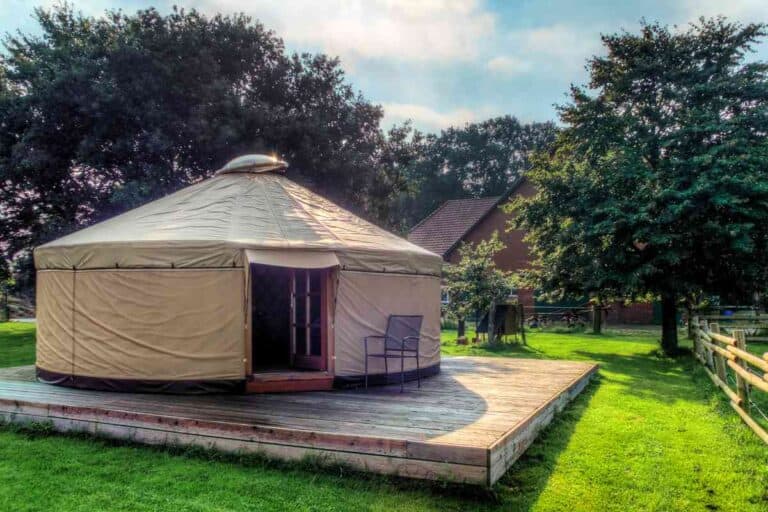Yurt Insulation: Staying Warm In a Yurt
Yurt living has a lot of advantages, such as low cost and living closer to nature. However, many potential yurt dwellers worry about whether they can stay warm during the winter months in what is mistakenly often considered a glorified tent.
Whether you live in the high desert or the cold northern regions, you will want insulation to keep a comfortable temperature during summer and winter, but how do you do that in a yurt? This is what we will explore in this article.
Are Yurts Insulated?
Most manufactured yurts come with only a base level of insulation that may suffice in very mild climates. But if you live in colder climates, you will need extra insulation. Yurt manufacturers offer additional insulation and insulation kits made for cold climates that include extra wall and roof insulation
An already well-insulated yurt will typically cost an additional $1,500 to $6,000 depending on yurt size, manufacturer, and level of insulation.
Yurt Insulation Options
What materials are commonly used for yurt insulation? Cotton is a very popular material for yurt covers. Cotton offers other benefits besides insulation, such as it being breathable. Often the fabric is a combination of cotton and polyester as polyester is very resistant against rot. Most yurts also have an additional layer of wool felt. Wool is a very efficient insulator and somewhat more affordable than cotton.
While cotton and wool are the most traditionally used insulation material, it is also the among the more expensive options. Yurt insulation can also consist of many other types of organic or synthetic materials, such as fiberglass, foam boards, and mineral wool.
Most modern manufacturers also offer foil-based radiant heat barrier insulation based on a material similar to mylar survival blankets. These products go under several names, such as Reflectix, EcoFoil, and EnerLayer. Instead of absorbing the heat, the barriers reflect it back to the source, keeping the yurt warm in the winter and cool in the summer. Another benefit of foils is that it also functions as a very effective vapor barrier, minimizing mold and mildew issues.
In practical terms, the radiant heat barrier has an impressive R-value. As the foil is a very thin material, it can not stand alone. Still, it is a very effective insulator when used in combination with a traditional insulation material such as cotton and wool or polyethylene foam.
Yurt Insulation Options and R-Value
An important factor when planning any insulation project is the material’s R-value. R-value is a measurement of the insulation’s ability to resist the heat transfer from one side of the insulation to the other. A high R-value means great resistance, i.e., better insulation. A high R-value is needed to keep the indoor heat from dissipating to the colder surroundings, but also if you need to and stay cool in a hot environment.
What insulation material has the highest R-value? Below are commonly used materials and their respective R-values:
| Insulating material | R-value per inch |
|---|---|
| Wool | 3.5 to 3.8 |
| Cotton / denim batts | 3.5 |
| Cellulose | 3.2 to 3.9 |
| Gypsum | 0.9 |
| Hemp | 3.5 |
| OSB/particle Board | 1.1 to 1.4 |
| Mineral wool | 3.1 to 4.0 |
| Fiberglass | 3.1 to 4.3 |
| Styrofoam | 5 |
| Polystrene board | 3.8 to 5.0 |
| Polyisocyanurate | 5.6 to 8.0 |
| Open-cell foam | 3.5 to 3.6 |
| Closed-cell foam | 6.0 to 6.5 |
So What Is the Best Yurt Insulation Material?
The most efficient yurt insulation is a combination of modern reflective foil with a layer of closed-cell foam, as it offers the best insulation per inch. If you prefer a more traditional look and feel, part or all of the foam can be substituted by wool.
However, what works for you depends on your personal preferences, too. Some people prefer to avoid synthetic materials altogether, in which case the traditional Mongolian combination of wool and cotton is an excellent option that has served Asian nomads well for centuries. It is recommended to use canvas or a synthetic outer layer to protect the yurt against mildew in most cases.
How Much Does It Cost to Insulate a Yurt?
The cost of insulating a yurt will vary a lot depending on its size and the materials used. Natural materials, such as wool, are not cheap, but there are various options in several price ranges. Below are the typical costs of materials commonly used in yurt insulation:
- cotton batt: $1.2 to $1.5 per sq. ft.
- wool batt: $0.67 to $0.96 per sq. ft.
- fiberglass batt: $0.45 per sq. ft.
- cellulose batt: $0.50 to 0.55 per sq. ft.
- fiberglass batt: $0.35 – 0.40 per sq. ft.
Based on these prices, insulating a 20-foot yurt’s walls and ceiling (645 sq. ft.) will cost from $ 225.75 to $967.50, depending on the material used. Add to that a layer of double reflective insulation from your local improvement retailer (about $0.40 per sq. ft.), and you will be able to stay warm under most conditions.
As you can see, you could save some money if you are willing to do it yourself rather than buying the insulation kits from yurt manufacturers.
DIY Yurt Insulation Ideas
Use insulated window covers. They can be rolled up during the day when you need more light and want to take advantage of the fun, and then rolled back down during the night.
Dividing the yurt into separate rooms will also have an effect, as the room where your heat source is located will heat up very quickly while the other rooms will remain relatively cooler. If you really want to save on heat you could divide it into a few rooms and stay in the warmer room during the winter.
Fight draft. While you should air out regularly and maintain a good airflow by the dome at the top, any draft (i.e., airflow coming in from lower down) will cool your yurt significantly.
How to Insulate a Yurt
Insulating Yurt Walls
The covers partly insulate the walls. Covers made from thick layers of materials with high R-values will provide efficient insulation. You can add insulation batts of any thickness and made from any of the material types mentioned above to achieve pretty much any layer of insulation needed.
Insulating a Yurt Ceiling
Add insulation between the rafters, like foam boards or mineral wool batt. If you do not like the look of insulation materials in the ceiling, you can cover it by attaching any fabric of your own choosing to the rafters.
One great way to heat a yurt for free is by having a full-sized dome/skylight that allows as much sunlight inside the yurt as possible. While all yurts need ventilation, those living in hot climates should make sure to choose a dome that will enable very efficient airflow.
Yurt Floor and Platform Insulation
If your yurt is to be built on a permanent foundation, you should use the same methods as any other building in terms of insulating the floor. If you really want to go “hi-tech,” you can use the opportunity to get heated floors. In addition to it being comfortable, heated floors are also an efficient way to heat your home.
If you raise the yurt on a wooden platform, you can insulate the space below it. One affordable solution is to stuff it with haybales below the existing floor insulation. Remember to enclose it in plastic to keep it from molding, and use a solid wire mesh to keep rodents out. Also add skirts that block airflow below the platform.
If you keep the yurt directly on the ground, you will have to keep the yurt wood stove running day and night. Add some thick carpets that can provide some insulation between you and the ground.



![How Do Yurts Hold Up In Storms? [Life-Saving Facts!]](https://freedomresidence.com/wp-content/uploads/2022/05/How-Do-Yurts-Hold-Up-In-Storms-768x512.jpg)
![Are Yurts Good For Hot Weather? [4 Tips To Stay Cool!]](https://freedomresidence.com/wp-content/uploads/2022/05/Can-You-Live-in-a-Yurt-Year-Round-2-768x512.jpg)

